Javier Romero
University of Potsdam, Germany
From Field to Drone: Domain Drift Tolerant Automated Multi-Species and Damage Plant Semantic Segmentation for Herbicide Trials
Aug 11, 2025Abstract:Field trials are vital in herbicide research and development to assess effects on crops and weeds under varied conditions. Traditionally, evaluations rely on manual visual assessments, which are time-consuming, labor-intensive, and subjective. Automating species and damage identification is challenging due to subtle visual differences, but it can greatly enhance efficiency and consistency. We present an improved segmentation model combining a general-purpose self-supervised visual model with hierarchical inference based on botanical taxonomy. Trained on a multi-year dataset (2018-2020) from Germany and Spain using digital and mobile cameras, the model was tested on digital camera data (year 2023) and drone imagery from the United States, Germany, and Spain (year 2024) to evaluate robustness under domain shift. This cross-device evaluation marks a key step in assessing generalization across platforms of the model. Our model significantly improved species identification (F1-score: 0.52 to 0.85, R-squared: 0.75 to 0.98) and damage classification (F1-score: 0.28 to 0.44, R-squared: 0.71 to 0.87) over prior methods. Under domain shift (drone images), it maintained strong performance with moderate degradation (species: F1-score 0.60, R-squared 0.80; damage: F1-score 0.41, R-squared 0.62), where earlier models failed. These results confirm the model's robustness and real-world applicability. It is now deployed in BASF's phenotyping pipeline, enabling large-scale, automated crop and weed monitoring across diverse geographies.
3DGH: 3D Head Generation with Composable Hair and Face
Jun 25, 2025Abstract:We present 3DGH, an unconditional generative model for 3D human heads with composable hair and face components. Unlike previous work that entangles the modeling of hair and face, we propose to separate them using a novel data representation with template-based 3D Gaussian Splatting, in which deformable hair geometry is introduced to capture the geometric variations across different hairstyles. Based on this data representation, we design a 3D GAN-based architecture with dual generators and employ a cross-attention mechanism to model the inherent correlation between hair and face. The model is trained on synthetic renderings using carefully designed objectives to stabilize training and facilitate hair-face separation. We conduct extensive experiments to validate the design choice of 3DGH, and evaluate it both qualitatively and quantitatively by comparing with several state-of-the-art 3D GAN methods, demonstrating its effectiveness in unconditional full-head image synthesis and composable 3D hairstyle editing. More details will be available on our project page: https://c-he.github.io/projects/3dgh/.
Compiling Metric Temporal Answer Set Programming
Jun 09, 2025Abstract:We develop a computational approach to Metric Answer Set Programming (ASP) to allow for expressing quantitative temporal constrains, like durations and deadlines. A central challenge is to maintain scalability when dealing with fine-grained timing constraints, which can significantly exacerbate ASP's grounding bottleneck. To address this issue, we leverage extensions of ASP with difference constraints, a simplified form of linear constraints, to handle time-related aspects externally. Our approach effectively decouples metric ASP from the granularity of time, resulting in a solution that is unaffected by time precision.
FRESA:Feedforward Reconstruction of Personalized Skinned Avatars from Few Images
Mar 24, 2025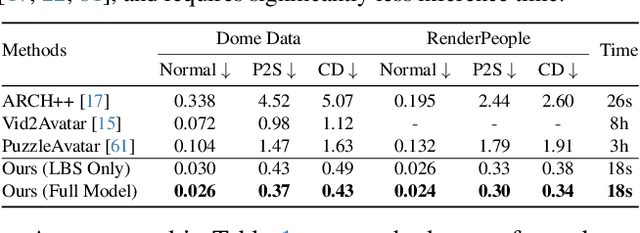
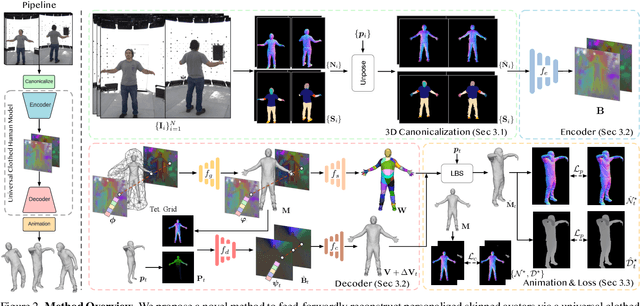
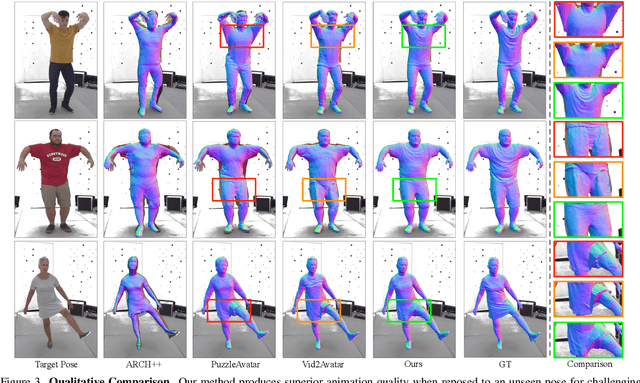
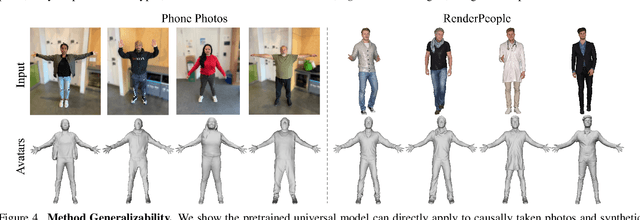
Abstract:We present a novel method for reconstructing personalized 3D human avatars with realistic animation from only a few images. Due to the large variations in body shapes, poses, and cloth types, existing methods mostly require hours of per-subject optimization during inference, which limits their practical applications. In contrast, we learn a universal prior from over a thousand clothed humans to achieve instant feedforward generation and zero-shot generalization. Specifically, instead of rigging the avatar with shared skinning weights, we jointly infer personalized avatar shape, skinning weights, and pose-dependent deformations, which effectively improves overall geometric fidelity and reduces deformation artifacts. Moreover, to normalize pose variations and resolve coupled ambiguity between canonical shapes and skinning weights, we design a 3D canonicalization process to produce pixel-aligned initial conditions, which helps to reconstruct fine-grained geometric details. We then propose a multi-frame feature aggregation to robustly reduce artifacts introduced in canonicalization and fuse a plausible avatar preserving person-specific identities. Finally, we train the model in an end-to-end framework on a large-scale capture dataset, which contains diverse human subjects paired with high-quality 3D scans. Extensive experiments show that our method generates more authentic reconstruction and animation than state-of-the-arts, and can be directly generalized to inputs from casually taken phone photos. Project page and code is available at https://github.com/rongakowang/FRESA.
Avat3r: Large Animatable Gaussian Reconstruction Model for High-fidelity 3D Head Avatars
Feb 27, 2025Abstract:Traditionally, creating photo-realistic 3D head avatars requires a studio-level multi-view capture setup and expensive optimization during test-time, limiting the use of digital human doubles to the VFX industry or offline renderings. To address this shortcoming, we present Avat3r, which regresses a high-quality and animatable 3D head avatar from just a few input images, vastly reducing compute requirements during inference. More specifically, we make Large Reconstruction Models animatable and learn a powerful prior over 3D human heads from a large multi-view video dataset. For better 3D head reconstructions, we employ position maps from DUSt3R and generalized feature maps from the human foundation model Sapiens. To animate the 3D head, our key discovery is that simple cross-attention to an expression code is already sufficient. Finally, we increase robustness by feeding input images with different expressions to our model during training, enabling the reconstruction of 3D head avatars from inconsistent inputs, e.g., an imperfect phone capture with accidental movement, or frames from a monocular video. We compare Avat3r with current state-of-the-art methods for few-input and single-input scenarios, and find that our method has a competitive advantage in both tasks. Finally, we demonstrate the wide applicability of our proposed model, creating 3D head avatars from images of different sources, smartphone captures, single images, and even out-of-domain inputs like antique busts. Project website: https://tobias-kirschstein.github.io/avat3r/
Relightable Full-Body Gaussian Codec Avatars
Jan 24, 2025



Abstract:We propose Relightable Full-Body Gaussian Codec Avatars, a new approach for modeling relightable full-body avatars with fine-grained details including face and hands. The unique challenge for relighting full-body avatars lies in the large deformations caused by body articulation and the resulting impact on appearance caused by light transport. Changes in body pose can dramatically change the orientation of body surfaces with respect to lights, resulting in both local appearance changes due to changes in local light transport functions, as well as non-local changes due to occlusion between body parts. To address this, we decompose the light transport into local and non-local effects. Local appearance changes are modeled using learnable zonal harmonics for diffuse radiance transfer. Unlike spherical harmonics, zonal harmonics are highly efficient to rotate under articulation. This allows us to learn diffuse radiance transfer in a local coordinate frame, which disentangles the local radiance transfer from the articulation of the body. To account for non-local appearance changes, we introduce a shadow network that predicts shadows given precomputed incoming irradiance on a base mesh. This facilitates the learning of non-local shadowing between the body parts. Finally, we use a deferred shading approach to model specular radiance transfer and better capture reflections and highlights such as eye glints. We demonstrate that our approach successfully models both the local and non-local light transport required for relightable full-body avatars, with a superior generalization ability under novel illumination conditions and unseen poses.
Reasoning about Study Regulations in Answer Set Programming
Aug 08, 2024Abstract:We are interested in automating reasoning with and about study regulations, catering to various stakeholders, ranging from administrators, over faculty, to students at different stages. Our work builds on an extensive analysis of various study programs at the University of Potsdam. The conceptualization of the underlying principles provides us with a formal account of study regulations. In particular, the formalization reveals the properties of admissible study plans. With these at end, we propose an encoding of study regulations in Answer Set Programming that produces corresponding study plans. Finally, we show how this approach can be extended to a generic user interface for exploring study plans.
On the generalization of learned constraints for ASP solving in temporal domains
Jan 29, 2024Abstract:The representation of a dynamic problem in ASP usually boils down to using copies of variables and constraints, one for each time stamp, no matter whether it is directly encoded or via an action or temporal language. The multiplication of variables and constraints is commonly done during grounding and the solver is completely ignorant about the temporal relationship among the different instances. On the other hand, a key factor in the performance of today's ASP solvers is conflict-driven constraint learning. Our question is now whether a constraint learned for particular time steps can be generalized and reused at other time stamps, and ultimately whether this enhances the overall solver performance on temporal problems. Knowing full well the domain of time, we study conditions under which learned dynamic constraints can be generalized. We propose a simple translation of the original logic program such that, for the translated programs, the learned constraints can be generalized to other time points. Additionally, we identify a property of temporal problems that allows us to generalize all learned constraints to all time steps. It turns out that this property is satisfied by many planning problems. Finally, we empirically evaluate the impact of adding the generalized constraints to an ASP solver
URHand: Universal Relightable Hands
Jan 10, 2024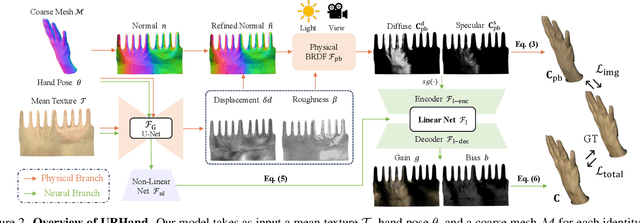
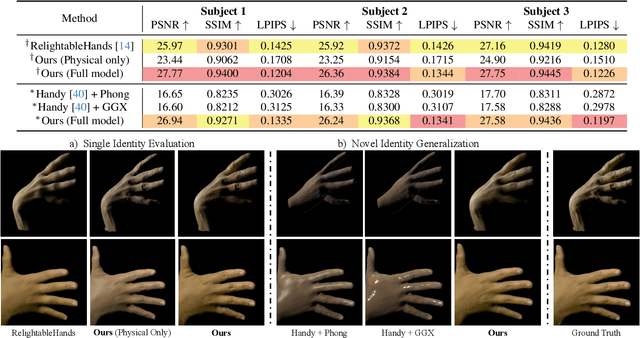

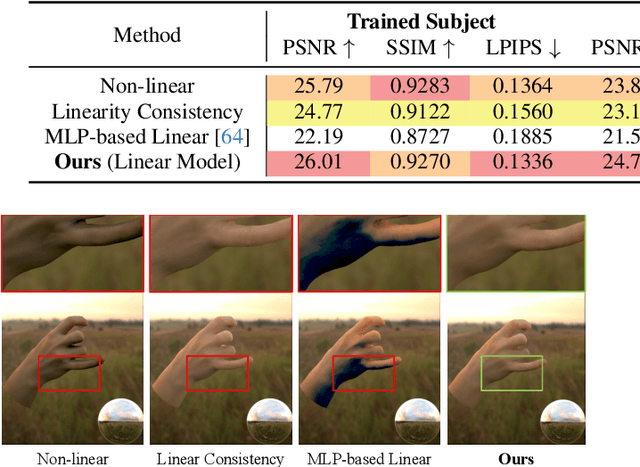
Abstract:Existing photorealistic relightable hand models require extensive identity-specific observations in different views, poses, and illuminations, and face challenges in generalizing to natural illuminations and novel identities. To bridge this gap, we present URHand, the first universal relightable hand model that generalizes across viewpoints, poses, illuminations, and identities. Our model allows few-shot personalization using images captured with a mobile phone, and is ready to be photorealistically rendered under novel illuminations. To simplify the personalization process while retaining photorealism, we build a powerful universal relightable prior based on neural relighting from multi-view images of hands captured in a light stage with hundreds of identities. The key challenge is scaling the cross-identity training while maintaining personalized fidelity and sharp details without compromising generalization under natural illuminations. To this end, we propose a spatially varying linear lighting model as the neural renderer that takes physics-inspired shading as input feature. By removing non-linear activations and bias, our specifically designed lighting model explicitly keeps the linearity of light transport. This enables single-stage training from light-stage data while generalizing to real-time rendering under arbitrary continuous illuminations across diverse identities. In addition, we introduce the joint learning of a physically based model and our neural relighting model, which further improves fidelity and generalization. Extensive experiments show that our approach achieves superior performance over existing methods in terms of both quality and generalizability. We also demonstrate quick personalization of URHand from a short phone scan of an unseen identity.
From Audio to Photoreal Embodiment: Synthesizing Humans in Conversations
Jan 03, 2024



Abstract:We present a framework for generating full-bodied photorealistic avatars that gesture according to the conversational dynamics of a dyadic interaction. Given speech audio, we output multiple possibilities of gestural motion for an individual, including face, body, and hands. The key behind our method is in combining the benefits of sample diversity from vector quantization with the high-frequency details obtained through diffusion to generate more dynamic, expressive motion. We visualize the generated motion using highly photorealistic avatars that can express crucial nuances in gestures (e.g. sneers and smirks). To facilitate this line of research, we introduce a first-of-its-kind multi-view conversational dataset that allows for photorealistic reconstruction. Experiments show our model generates appropriate and diverse gestures, outperforming both diffusion- and VQ-only methods. Furthermore, our perceptual evaluation highlights the importance of photorealism (vs. meshes) in accurately assessing subtle motion details in conversational gestures. Code and dataset available online.
 Add to Chrome
Add to Chrome Add to Firefox
Add to Firefox Add to Edge
Add to Edge